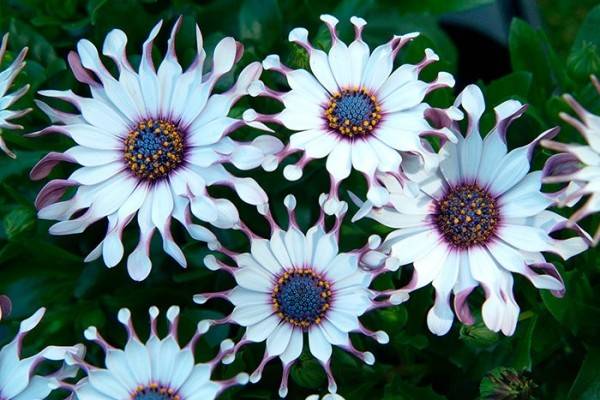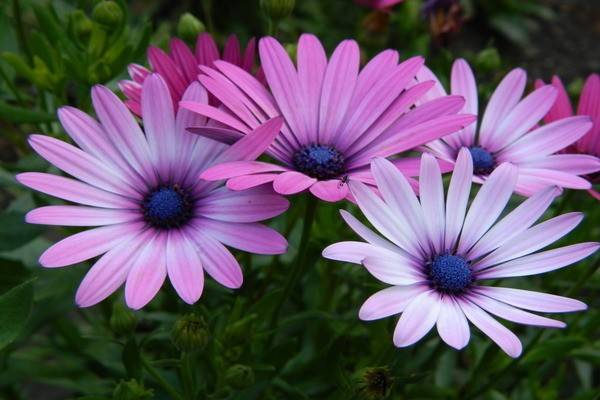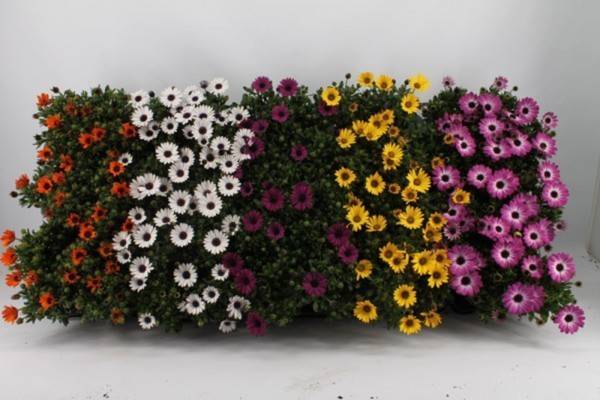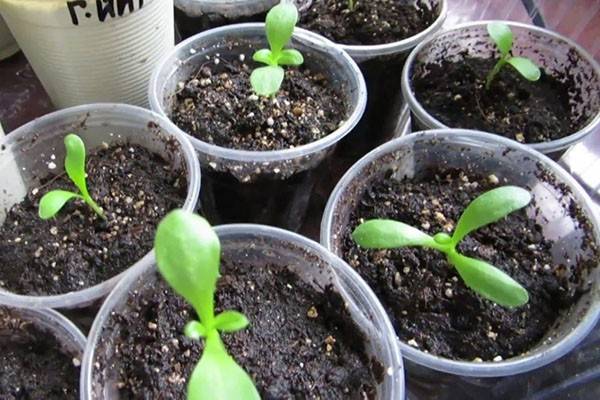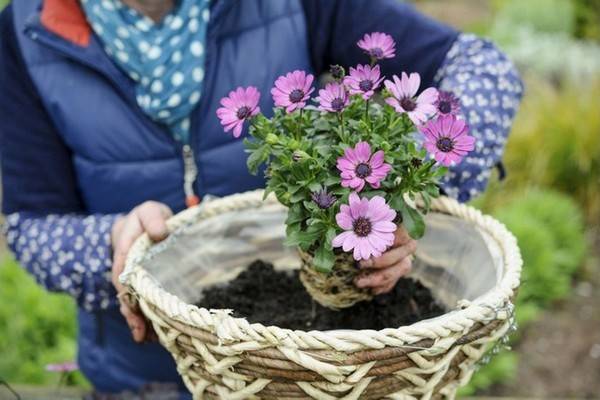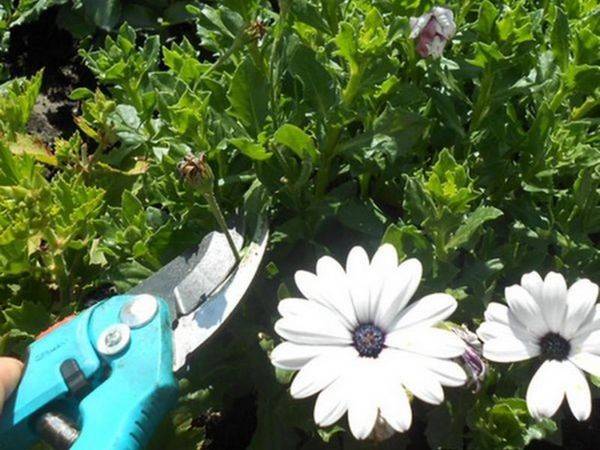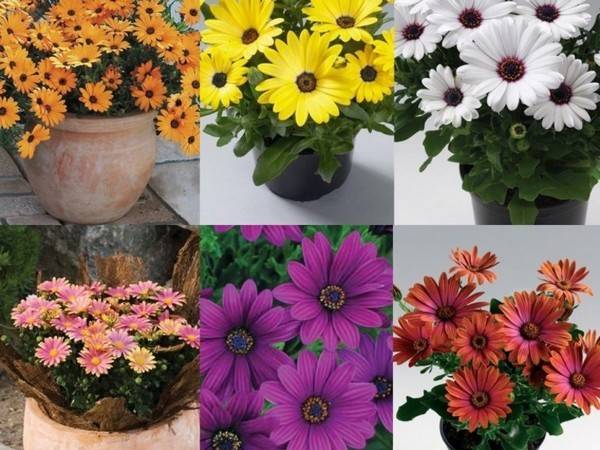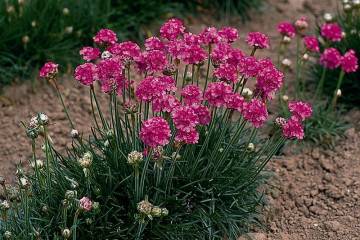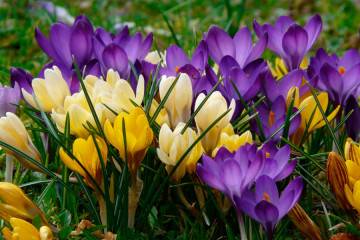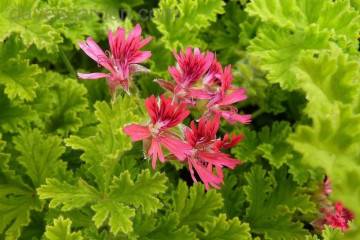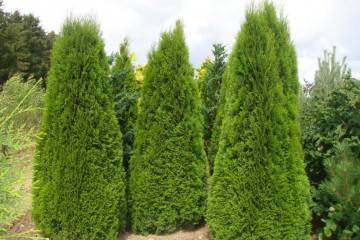Osteospermum flower - varieties and varieties
Content:
Osteospermum is a flower that is grown in home gardens by many growers. The culture is characterized by unpretentiousness, long flowering and bright colors of buds. Outwardly, it resembles an ordinary chamomile, but this does not diminish its decorative qualities.
Origin and appearance of osteospermum
The culture is a representative of perennial shrubs belonging to the Aster family. The height of the stems is 30 cm, the diameter of the flowers is 5 cm.The breeding work has made it possible to obtain variants that grow up to 75 cm with flowers up to 9 cm in diameter.
Osteospermum flowers naturally occur on the African continent and the Arabian Peninsula. Botanists distinguish more than 70 varieties of a plant that does not shed its foliage during the cold period, but only stops the formation of buds.
The inflorescences-baskets are formed from reed-type flowers, in their center there are tubular-type buds with a contrasting color: blue, black, light blue and smoky. After the end of flowering, an achene with long and dark seeds is formed.
Many novice florists are interested in: is osteospermum a perennial or annual flower? You should know that in nature and in a winter garden, a culture can live for many years, when grown on a personal plot - one season.
Dimorphoteka and osteospermum are the same plant or not
Both flowers belong to the aster family, have buds similar in structure and color. Crop petals differ:
- in the first, they are glossy and slightly collected towards the top;
- the second has a matte shade, with a disc-shaped bud and a dense top layer consisting of small green leaves.
Dimortofeca is determined by:
- for salmon, orange, light cream shades;
- flat seeds in an oval shell;
- fleshy foliage and pubescent stems.
Dimortofeca blooms only in June. Its buds are more like an ordinary calendula.
Types and varieties of osteospermum
The culture has long attracted the attention of gardeners and is grown all over the world. Earlier unknown varieties of perennial osteospermum have also appeared on the Russian market. There are a number of varieties that are more valuable than others.
Osteospermum Sky and Ice
It grows up to 75 cm, stands out with an unusual contrast of flowers: the outer ones have a snow-white shade, the inner ones are blue in color. Branched bushes until October throw out shoots of an early stage of development.
Osteospermum Magic Yellow
The subspecies surprises with a sunny yellow tone of petals that do not fade and retain bright colors until fading. Osteospermum Magik Yellow has an average height and compact size, it was bred by Dutch breeders.
Osteospermum Akila
It belongs to the undersized subspecies, it can be grown as a houseplant. The average growth of the Akila osteospermum is about 20 cm, the buds are up to 6 cm in diameter.With the proper organization of winter recreation, it can grow up to 6-7 years old and does not require transshipment.
Osteospermum Eklona
Refers to common varieties. It grows up to 0.5 m in height. The inflorescences reach a diameter of 8 cm. Their middle is painted in a violet-red tone, and pinkish veins are present on the snow-white outer petals.
Osteospermum Pass
The variety is suitable for growing in small containers, since it is characterized by a low growth of up to 25 cm. The buds are up to 5 cm in diameter. The color of the petals is diverse, it contains snow-white, pinkish, lavender, pale lilac, purple colors. Some hybrids have petals that are flattened in the middle.
Osteospermum mix
Used to decorate alpine slides, used in landscape design. The line includes medium-sized hybrid mixes - Flower Power Double (with double buds), Double Parple and others.
Reproduction of osteospermum
The full description of planting and caring for osteospermum indicates that it does not tolerate frost, a sharp drop or increase in temperature at night and during the day. In areas with warm climates, the plant can grow for several years in open ground or in flowerpots on verandas.
Growers prefer to propagate osteospermum using a vegetative method or seed. For cultivation of varietal hybrids, cuttings are better suited, since the daughter plant in this case receives all the specific characteristics of its variety.
Growing osteospermum from seeds
The main thing to know when growing osteospermum from seeds is when to plant it for seedlings. As a rule, this is done at the end of winter or at the beginning of spring. Seeds are sown in plastic cups or general containers. The soil is abundantly moistened, and the container is covered with plastic wrap and sent to a warm room.
In the spring, after warming up the soil, you can sow the crop directly into the open ground. In any case, the seeds are only slightly pressed into the soil. Their deep burial can cause them not to germinate. Experienced gardeners plant pre-cleaned material with peeled off the upper skin or cracks made on it, which helps the grains absorb moisture and, therefore, more rapid emergence of sprouts.
After the appearance of the first sprouts, the film is removed from the containers. It is recommended to harden young plants before planting in open ground. To do this, they are sent to fresh air during the daytime, each day increasing the time spent in the sun to 5-6 hours. Plants are hardened for two weeks. After that, it will be easier for them to endure the night temperature drop. Seedlings are planted in open ground after the end of frost on the soil.
Propagation by cuttings
For grafting, the mother shrub is transferred from autumn to home conditions and kept in a warm room at a temperature of + 12-15 degrees. The soil is regularly moistened, avoiding drying out.
Cuttings are cut from the top of the shoots and sent to the water. In it, they quickly release roots and easily root in loose and nutritious soil. If grafting is carried out from indoor individuals, then cutting is done from non-flowering shoots.
What is needed for planting osteospermum
Osteospermum requires a substrate enriched in minerals and humus with a neutral reaction. The flower prefers sunny areas, but can grow in partial shade.The main problem is the tendency to develop root rot, due to which areas with a close location of groundwater are not used. In the holes in which the osteospermum will be planted, drainage must be done.
How to feed osteospermum for lush flowering
Regardless of whether the osteospermum flower is grown, like a perennial or an annual, for normal development it requires feeding with useful substances, consisting of ash and humus. With the development of buds, spraying is carried out with complex compositions for indoor crops.
Mineral fertilizer is diluted in accordance with the instructions, the amount of water is doubled. This approach prevents scalding of the petals. Top dressing is carried out with a break of 21 days.
How to preserve osteospermum in winter
In areas with a southern climate, where there are no temperatures below -10 degrees in winter, a shelter consisting of spruce or pine branches and peat is used to preserve shrubs. In temperate climates, the culture needs to be transplanted into containers and transferred to housing. After the procedure, the bushes continue to delight with flowers until the end of December.
Why osteospermum does not bloom
There are two main reasons for the problem:
- In hot weather, the culture stops flowering and begins to actively form testicles. To avoid this phenomenon, it is necessary to carry out drip irrigation and shade the shrub.
- Excessive nitrogen content provokes abundant growth of the green part. The number of buds is significantly reduced.
Osteospermum: growing in pots
For indoor maintenance, species with medium and low growth are selected. In winter, it is necessary to make a mandatory pause - in December-March. With the arrival of spring, the soil in the pot must be loosened and fed. Watering is combined with fertilization, which are carried out weekly.
Growing osteospermum from seeds at home
For planting work, pots are bought with the expectation that the bushes will be in them for 3-4 years. The container is filled in a quarter with drainage material, and a loose soil mixture is poured on top. The rest of the manipulations do not differ from growing seedlings.
Watering and feeding
Florists advise using liquid mineral formulations. The shrub does not tolerate an excess of fertilizers, they are diluted with water for irrigation (1/4 of the recommended volume). Insufficient moisture of the substrate leads to crushing of the inflorescences, and excessive moisture leads to rotting of the root system.
Correct implementation of the recommendations on agricultural technology will help to get healthy plants that bloom for a long time. The buds retain their freshness for a long time, which allows you to decorate summer cottages and flower beds with culture, use it as an indoor flower or as an element of the landscape. The culture can be combined with the same annuals; some gardeners prefer to plant several varieties of it, of different sizes.
A distinctive feature of osteospermum is ideal immunity, in which most diseases and pests bypass shrubs. When planted on site, they require good lighting and soil with sufficient drainage. Taking care of shrubs is easy, even a beginner in gardening can handle the procedure
An unpretentious plant, with proper watering and regular weeding, decorates the garden with its unusual and bright buds.
